Guinea pigs are adorable small pets that fill our lives with joy. As responsible pet owners, it’s natural to want to provide them with a well-rounded diet that includes a variety of vegetables and fruits. But, can guinea pigs eat pumpkins? The short answer is yes, but there are certain precautions you must take to ensure your pet’s safety.
Feeding your guinea pig has its challenges, especially if you’re unfamiliar with what they can or cannot eat. Pumpkins, being high in fiber and vitamin A, can provide some nutritional benefits to your pet.
However, it’s crucial to know how to safely incorporate pumpkins into your guinea pig’s diet to avoid any potential harm. In this article, we will explore safe feeding tips, nutritional value, benefits, risks, precautions, preparation, serving size, and frequency, among other vital information to help you make informed decisions.
Key Takeaways
- Pumpkins can be a safe and nutritious addition to your guinea pig’s diet, but safe feeding practices must be followed at all times.
- Consult with a veterinarian before incorporating new foods into your pet’s diet.
- Always prepare pumpkins appropriately and remove any seeds or skin before feeding them to your pet.
- Watch for signs of allergies or digestive issues when feeding pumpkins and seek veterinary care if necessary.
- Provide your guinea pig with a balanced diet that includes a variety of vegetables and fruits.
Nutritional Value of Pumpkins for Guinea Pigs
When it comes to feeding your guinea pig, it is important to select foods that align with their dietary needs. Pumpkins are a great option as they are rich in vitamins and minerals that can benefit your pet’s overall health.
Vitamins
Pumpkins are an excellent source of Vitamin C, an essential nutrient that guinea pigs require to maintain a healthy immune system. They also contain Vitamin A, which promotes healthy vision and skin function.
Minerals
In addition to vitamins, pumpkins are also high in minerals such as potassium and calcium. Potassium helps regulate fluid balance and supports heart function, while calcium is important for maintaining strong bones and teeth.
Fiber
Pumpkins are a good source of fiber, which can help promote healthy digestion and prevent constipation in guinea pigs. The fiber found in pumpkins can also promote a feeling of fullness, which can lead to a more balanced diet for your pet.
Incorporating pumpkins into your guinea pig’s diet can provide them with valuable nutrients that support their overall well-being. Consult with your veterinarian to determine the appropriate serving size and frequency of feeding pumpkins to your pet.
Benefits of Feeding Pumpkins to Guinea Pigs
Feeding pumpkins to your guinea pig can have a wide range of benefits for your furry friend. Here are some of the potential advantages of incorporating pumpkin into your guinea pig’s diet:
1. Supports Digestive Health
As herbivores, guinea pigs have a delicate digestive system that requires a lot of fiber to function correctly. Pumpkins are rich in fiber and can help regulate your guinea pig’s digestion. This can prevent constipation and other digestive issues that may arise if your pet is not receiving enough fiber in their diet.
2. Provides Hydration
Pumpkins are also an excellent source of water, which is essential for your guinea pig’s overall health. By incorporating pumpkins into your pet’s diet, you can help ensure that they stay hydrated and healthy.
3. Offers Enrichment
Introducing new foods into your guinea pig’s diet can help keep them mentally stimulated and prevent boredom. Pumpkins can provide a fun and exciting addition to your pet’s mealtime, keeping them happy and engaged.
By feeding pumpkins to your guinea pig, you can provide them with valuable nutrients and add some variety to their diet. However, it is crucial to note that pumpkins should still only make up a small portion of your pet’s overall food intake. In the next section, we will discuss the risks and precautions of feeding pumpkins to guinea pigs.
Risks and Precautions When Feeding Pumpkins to Guinea Pigs
While pumpkins are generally safe for guinea pigs to consume, there are a few risks and precautions to be aware of to ensure your pet’s safety and well-being.
Risks of feeding pumpkins to guinea pigs
- Overeating: Like with any food, excessive intake of pumpkins can lead to obesity, digestive upset, and other health problems.
- Spoilage: Pumpkins can quickly spoil when left at room temperature, leading to gastrointestinal issues and bacterial infections in your pet.
- Oxalate content: High levels of oxalates, a natural compound found in pumpkin leaves and rinds, can cause urinary problems and kidney stones in some guinea pigs.
Precautions for feeding pumpkins to guinea pigs
- Limit serving size: While pumpkins offer many benefits, it’s crucial to limit the serving size and frequency of pumpkin intake to avoid overfeeding and potential health complications. Try feeding pumpkin in small portions, no more than twice a week.
- Monitor your pet: Keep an eye on your guinea pig’s behavior after feeding them pumpkin. If you notice any GI upset, discontinue feeding pumpkin and consult your veterinarian for further guidance.
- Prepare pumpkin properly: Always wash the pumpkin before serving it to your pet, cut off any moldy or spoiled parts, and cook the pumpkin to remove any potential harmful bacteria or toxins.
By following these risks and precautions when feeding pumpkins to guinea pigs, you can ensure your pet’s safety and health while providing them with a tasty and nutritious treat.
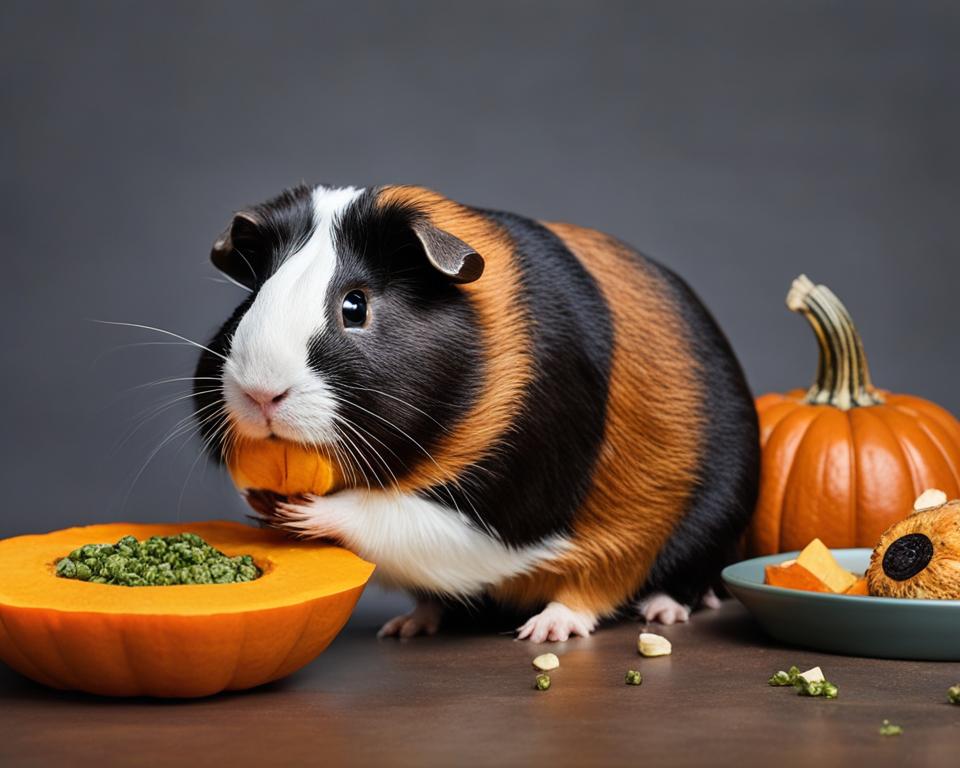
Preparing Pumpkin for Guinea Pig Consumption
If you’ve decided to add pumpkin to your guinea pig’s diet, it’s essential to prepare it the right way. Follow these easy steps to ensure your pet’s safety and enjoyment.
Cooking the Pumpkin
Start by washing the pumpkin thoroughly under cold, running water. Cut it into small, manageable chunks, removing all seeds and the tough outer skin. Boil the chunks in a small pot of water for about 10-15 minutes or until soft. Alternatively, you can bake the pumpkin in the oven on a baking sheet at 350°F for 45 minutes.
Cutting the Pumpkin
Once the pumpkin is cooked, let it cool down before cutting it into small pieces that are appropriate for your guinea pig’s size. Avoid giving your pet large chunks that may be difficult to chew and swallow.
Serving the Pumpkin
Now that the pumpkin is ready, you can serve it to your guinea pig. Keep in mind that some guinea pigs may prefer warm, soft pumpkin, while others may like it cool and crisp. Offer a small amount at a time to see how your pet likes it and adjust the serving size accordingly. Remember to remove any uneaten pumpkin after a few hours to prevent spoilage.
By following these simple steps, you can safely and easily prepare pumpkins for your furry friend to enjoy. Your guinea pig will appreciate the tasty and healthy addition to their diet!
Serving Size and Frequency of Pumpkins for Guinea Pigs
When it comes to feeding your guinea pig pumpkin, it is essential to provide the appropriate serving size and frequency to ensure their health and well-being. While pumpkins offer numerous benefits, too much of a good thing can be harmful to your pet.
Serving Size
The recommended serving size of pumpkin for guinea pigs is a small piece, approximately the size of their eye, per day. This is equivalent to around one tablespoon of pumpkin puree per day. It’s important not to overfeed them, as this can lead to digestive problems, weight gain, and other health concerns.
Frequency of Feeding
While pumpkins are safe for guinea pigs to eat regularly, they should not make up a significant portion of their diet. It is recommended to feed them pumpkin once or twice a week as a treat or part of a balanced diet. Overfeeding pumpkins can lead to diarrhea or other negative health effects.
Remember to always introduce new foods gradually and monitor your guinea pig for any adverse reactions. Consult with your veterinarian if you have any concerns about feeding pumpkins or any other foods to your pet.
Signs of Allergy or Digestive Issues in Guinea Pigs
While pumpkins can be a healthy and enjoyable addition to your guinea pig’s diet, it is important to keep an eye out for any signs of allergies or digestive issues that may arise. Some guinea pigs may have sensitivities to certain foods, including pumpkins.
If your guinea pig displays any of the following symptoms after consuming pumpkins, they may be experiencing an allergic reaction:
- Itching or rash
- Sneezing or coughing
- Watery eyes or nose
- Difficulty breathing
Digestive issues may also occur if your guinea pig consumes too many pumpkins or you do not prepare them properly. Look out for the following signs:
- Diarrhea
- Bloating
- Gas
- Loss of appetite
If you notice any of these symptoms, it is important to monitor your guinea pig closely and seek veterinary care if necessary.
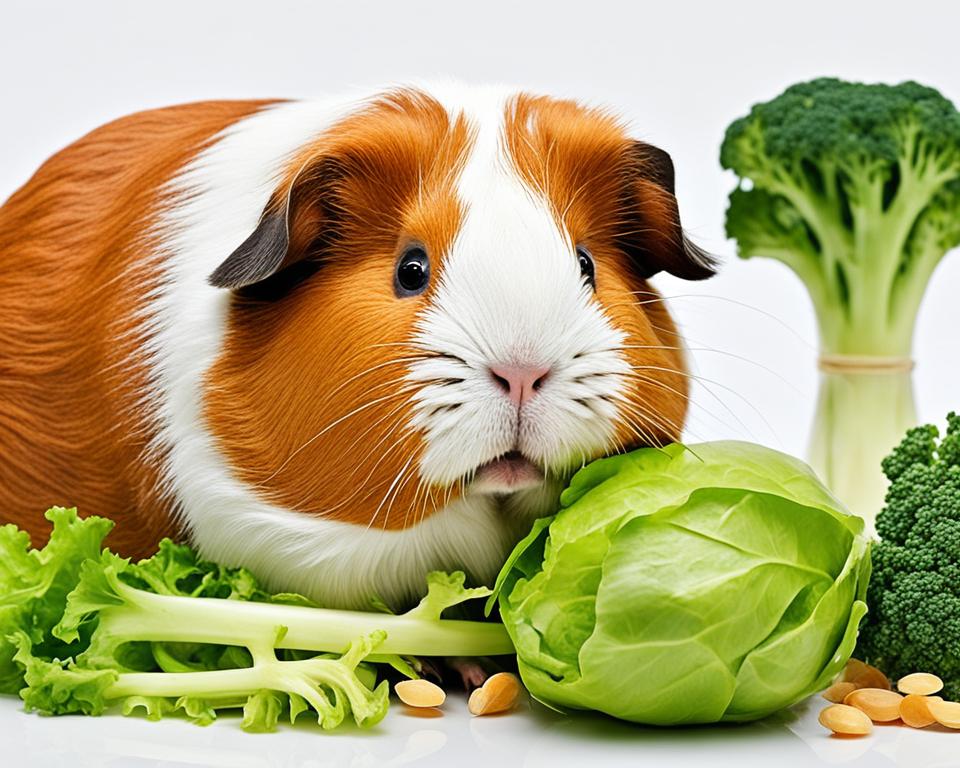
Other Safe Vegetables and Fruits for Guinea Pigs
While pumpkins can be a nutritious addition to your guinea pig’s diet, it’s important to offer a variety of safe and healthy foods to ensure they receive a balanced diet. Here are some other vegetables that are safe for guinea pigs to eat:
- Carrots
- Bell peppers
- Cucumbers
- Celery
- Tomatoes
- Zucchini
- Green beans
- Romaine lettuce
When it comes to fruits, moderation is key as they contain high levels of sugar:
- Apples
- Bananas
- Blueberries
- Melons
- Strawberries
Remember to introduce new foods slowly and in small amounts to avoid digestive discomfort. It’s always a good idea to consult with a veterinarian or a guinea pig nutrition specialist to ensure your pet’s diet is balanced and meets their specific nutritional needs.
Creating a Balanced Diet for Guinea Pigs
A balanced diet is the key to keeping your guinea pig healthy and happy. It’s essential to provide a variety of foods to ensure your pet gets all the nutrients they need.
When it comes to choosing foods for your guinea pig, opt for fresh produce that is high in vitamin C and fiber. In addition to pumpkins, some other safe vegetables to feed your furry friend include:
- Carrots
- Bell Peppers
- Spinach
- Kale
- Cucumber
It’s crucial to avoid feeding your pet foods that are high in sugar, salt, and fat. These can lead to obesity and other health issues.
When planning out your guinea pig’s diet, aim for a mix of fresh fruits, vegetables, hay, and fortified pellets. Guinea pigs require a constant supply of hay to support digestive health.
Keep in mind that each guinea pig is different, and their dietary needs may vary depending on their age and activity level. Always monitor your pet’s body weight and adjust their diet accordingly.
Incorporating pumpkins into your guinea pig’s diet can be a tasty and nutritious addition. Just be sure to follow safe feeding practices and balance their diet with a variety of other foods.
Conclusion
In conclusion, feeding pumpkins to your guinea pig can offer many nutritional benefits and potential advantages, such as supporting digestive health and providing hydration. However, it is crucial to follow safe feeding practices, including appropriate preparation and monitoring for any signs of allergy or digestive issues. Additionally, it is essential to provide a balanced diet for your pet by incorporating other safe vegetables and fruits.
Remember to always prioritize the well-being of your furry friend and consult with a veterinarian if you have any concerns about their diet or health. With proper care and attention, your guinea pig can enjoy the occasional pumpkin treat as a delicious and nourishing addition to their diet.
FAQ
Can guinea pigs eat pumpkins?
Yes, guinea pigs can eat pumpkins. However, it is important to follow safe feeding tips to ensure their well-being.
What is the nutritional value of pumpkins for guinea pigs?
Pumpkins are packed with vitamins, minerals, and fiber that can benefit guinea pigs. They are a good source of vitamin C, which is essential for their health.
What are the benefits of feeding pumpkins to guinea pigs?
Feeding pumpkins to guinea pigs can support their digestive health, provide hydration, and offer enrichment for their overall well-being.
Are there any risks or precautions when feeding pumpkins to guinea pigs?
While pumpkins are generally safe for guinea pigs, it is essential to remove any seeds or rinds that may pose a choking hazard. Additionally, introduce pumpkins gradually to avoid digestive issues.
How should I prepare pumpkins for guinea pig consumption?
To prepare pumpkins for guinea pigs, cook them thoroughly, remove the seeds and rinds, and cut them into small, bite-sized pieces. Serve them at room temperature.
What is the appropriate serving size and frequency of pumpkins for guinea pigs?
Offer a small portion of pumpkin, about one to two tablespoons, once or twice a week. Remember to incorporate other vegetables and fruits into their diet for a balanced nutrition.
What are the signs of allergy or digestive issues in guinea pigs?
Signs of potential allergies or digestive issues in guinea pigs may include diarrhea, bloating, or changes in behavior. If you notice these symptoms, consult a veterinarian.
What other vegetables and fruits are safe for guinea pigs?
In addition to pumpkins, guinea pigs can enjoy a variety of safe vegetables and fruits such as carrots, bell peppers, apples, and strawberries. However, always introduce new foods gradually.
How can I create a balanced diet for my guinea pigs?
Ensure a balanced diet for your guinea pigs by offering a mix of hay, pellets, fresh vegetables, fruits, and limited treats like pumpkins. Consult a veterinarian for specific dietary recommendations.
What have we learned about feeding pumpkins to guinea pigs?
We have learned that guinea pigs can eat pumpkins safely by following proper feeding practices. With consideration for their nutritional needs, preparation methods, and monitoring their well-being, pumpkins can be a healthy addition to their diet.

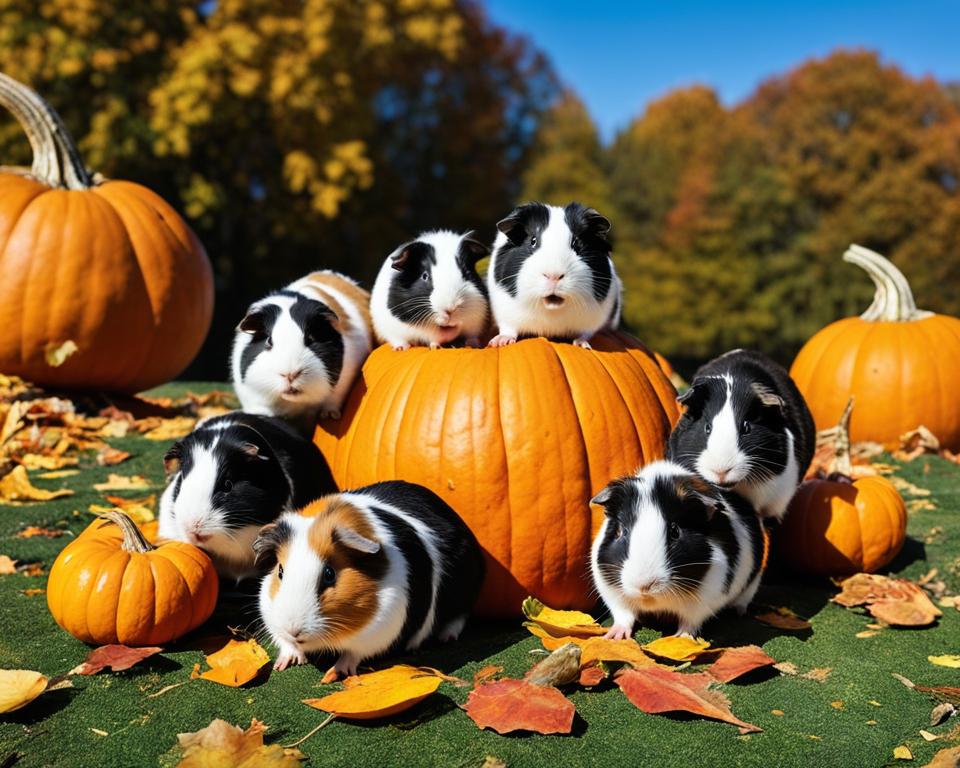
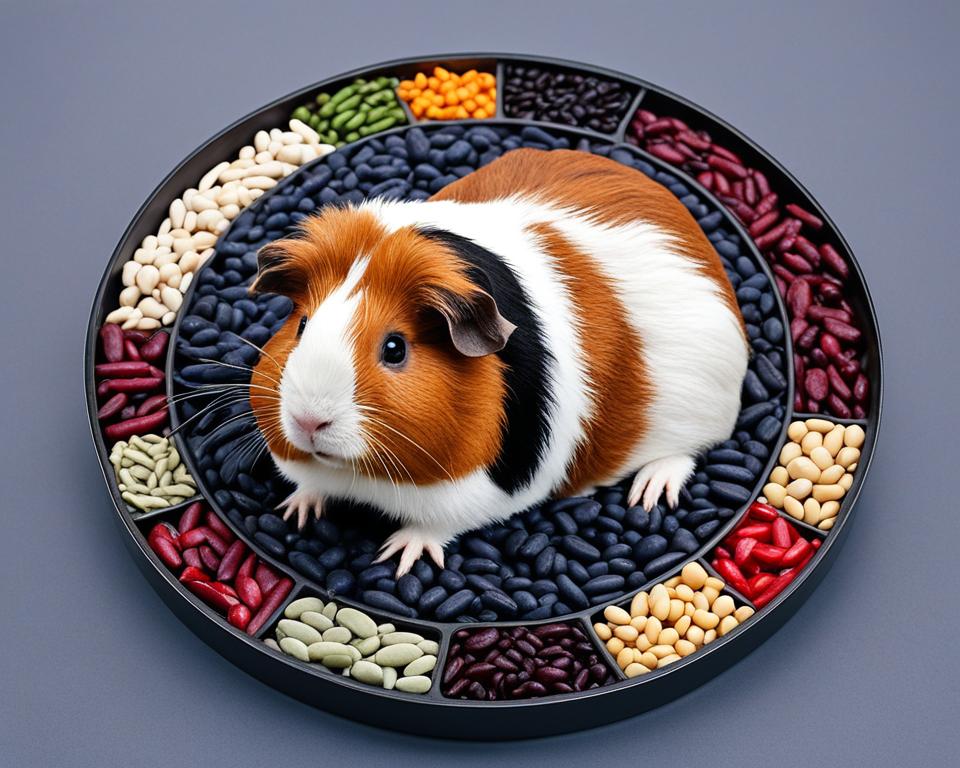
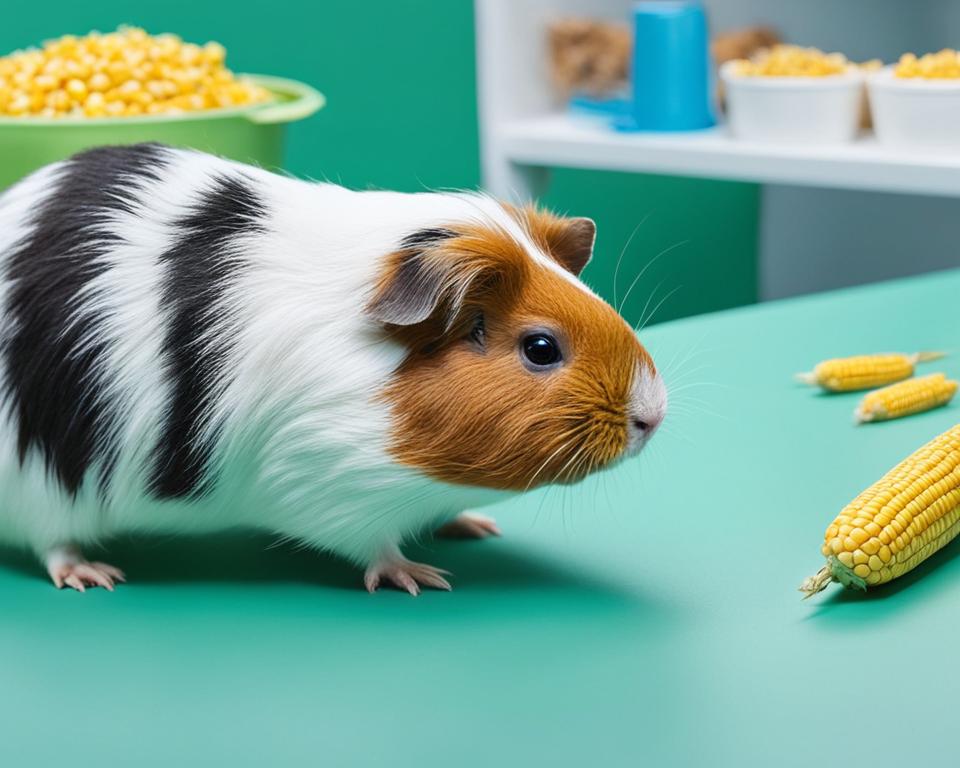
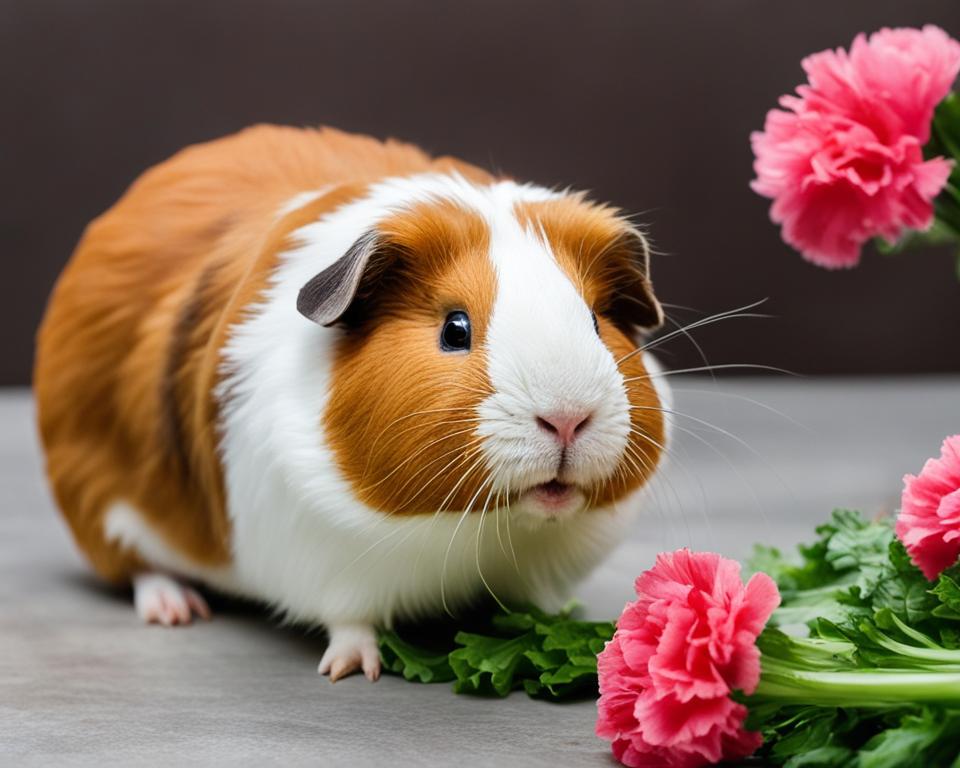
Leave a Reply